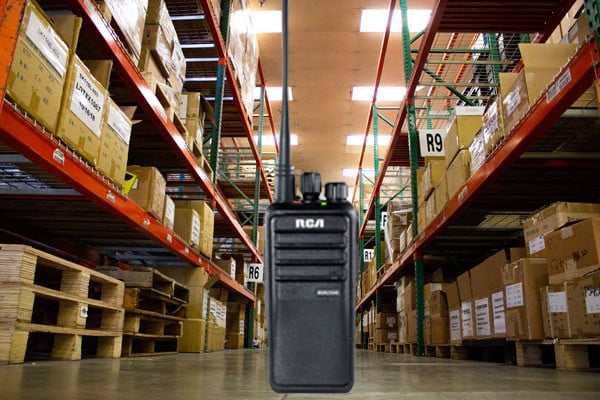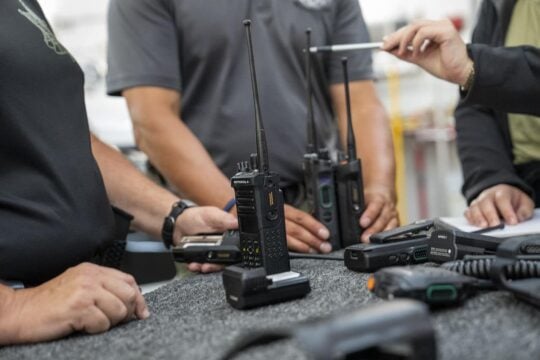
Portable Walkie Talkie’s Improve Employees Productivity
Ever since Motorola introduced one of the earliest two-way radios in the 1920’s, it was obvious that walkie talkie technology would be able to positively impact office environments and help employees become more productive. Even as more technology gets introduced into the work environment, and technological advances overhaul business models, two-way radios continue to be one of the most important tools to improve worker efficiency, productivity, and safety.
Core Benefits of 2-Way Radio Technology
No matter what industry work in, there are four critical areas where walkie talkie communications can help make your employees more productive and businesses become more successful and build community. Specifically, 2-way radios help improve safety, efficiency, and productivity.
Immediacy and Efficiency – Portable two-way radios are the perfect tool for maximizing efficiency in any business setting. In fact, studies have found that two-way radios can be so effective that they pay for themselves in just a couple of months because of the amount of time they save. Unplanned down time caused by equipment malfunctions, spills, or other disruptions can cause a domino effect that will impact your operation’s output.

In addition, operations can stop suddenly without notice, and that can be costly. However, with instant communication all it takes to figure out a quick solution and keep things moving is communication between two or more areas. Knowing where your people are in relation to where the problem has occurred can save time and money. Two-way radios can instantly connect multiple people which reduces response times when problems appear and improve results across the entire production line.
Productivity – Never before have companies had to work so hard to do more with less time. Margins are under constant pressure, and in just about every industry under the sun, managers are having to do more and more with less. Leveraging 2-way radios as a communication tool allows workers to instantly communicate with others and help them find quick solutions to problems that may occur.
And 2 way radios don’t have to be exclusive to industries like mining or oil refining. Even dentists have found that 2 way radios and walkie talkies can have a huge impact on their business.
A front office worker of a dental office in Arizona insists that offices that use 2-way radios are almost three times more efficient.
“Two-way radios help us a lot with time efficiency,” Susan Decker said. “Getting a hold of someone in the back office is much easier, and they can let me know about treatment changes without having to come up to the front. When I worked in offices without radios, we were constantly wasting time walking around to find people.”
Safety –Without professional communication tools, accidents can happen just because someone misunderstands an instruction. Discount two-way radio understands that radios provide crystal clear audio even in the nosiest of environments. For example, think about how noisy a construction site can be, where shouted instructions get lost in the sound of hammering and roaring trucks. High-quality two-way radios, especially when equipped with headphones, can make the difference between the safe completion of a task and a dangerous accident.
Durability – Professional quality two-way radios are designed to withstand the abuse of hard-working manufacturing plants. They can withstand being dropped on concrete, in water, or even in dust. There is no way cellular phones can withstand this kind of treatment. Consumer radios by contrast are usually built for infrequent use: weekend hunting trips, multiple car caravans, camping trips, amusement park visits, etc. They are lightweight with a thin plastic casing. Commercial radios are designed to be used for hours every day and are constructed with heavy-duty commercial housing. Many are built to military specifications and are waterproof with significant transmitting power.
Two-Way Radio Equipment to Incorporate into Your Job
|
quipment |
Model | Option 1 | Option 2 | Purpose |
| Repeater | RDR9000
A professional digital repeater system. |
RPX8100 RDS
Digital rapid deployment portable repeater. |
RPX8100 CRS
Public safety P25 repeater for heavy duty users. |
Repeater systems greatly help to extend the signal of your radio equipment |
| Two-Way Radios | RDR2500
Best value for reliable, durable, professional two-way radio. |
RDR2550
Affordable professional two-way radio with limited keypad. |
RDR2600
Exceptional durable two-way radio with full keypad function. |
Nothing beats two-way radios for improving safety and productivity. |
| Speaker Mics | RCA SM110-X83
Light duty RCA speaker mic. |
RCA SM220-X83
Medium duty RCA speaker mic. |
RCA SM310-X30S
Heavy duty RCA speaker mic. |
Speaker mics help extend the life of your radios and improve the safety of workers. |
| Holsters | RCA HL850FL
Leather two-way radio holster with fixed belt loop. |
RCA HN3500FL
Nylon two-way radio holster with standard belt loop and 1-year warranty. |
RCA HN3600FL
Nylon two-way radio holster with fixed belt loop and 1-year warranty. |
Holsters are the most cost-effective ways to protect your radios from daily wear and tear. |
| Mobile Radios | BRM300D
Digital and analog mobile two-way radio. |
RDR6350D
Digital mobile two-way radio with 40 watts and 100 channels. |
BRM300A
Analog mobile two-way radio that is cost effective. |
Mobile radios have greater power and are able to be used in automobiles. |
| Base Station | BRMAB
A cost effective analog base station that can be used for a wide range of applications. |
BRM300DB
A cost effective digital base station that can be used for a wide range of applications. |
RITRON JBS
Economy base station that is compact and easy to use. |
Base stations help anchor a central point of communication when there are multiple radio users. |
Two-Way Radios in A Crisis Situation

Two-Way Radios are incredibly valuable tools for industry, but they are especially valuable tools for crisis management as well. Imagine if someone works alone or in an isolated area. In many situations, a cell phone won’t have the immediacy, dependability, or reliability in a crisis. There are three specific features of two-way radios that can greatly improve survival in a true crisis situation. These include:
- The Man Down Feature
- The Lone Worker Feature
- Emergency Alert Button
The Man Down safety feature detects when there is a lack of movement or if the radio suddenly tilts horizontally, typical signs an accident or emergency is taking place. This application has to be programmed into the two-way radio and is designed to identify when a worker has fallen. When the radio senses lack of movement or a sudden horizontal tilt, a timer is activated which will initiate a “chirp” following a couple of seconds to notify other radio users that there could be an emergency. If the worker is fine but just accidentally tilted the radio, he/she can disable the alert without an emergency signal being sent.
However, if a full minute passes and the worker has not turned off the notification, an alarm will sound to other radios announcing that something is wrong and that the radio operator is unresponsive.
Unlike the Man Down safety feature, the Lone Worker feature is triggered when a worker fails to interact with the radio for a specific period of time. For example, let’s say a worker doesn’t touch the radio for 10 minutes, a pre-warning signal will sound reminding the worker to reset the timer by pressing a button or adjusting a knob. If the worker doesn’t interact with the radio in the next couple of minutes, an emergency notification will be sent to other predesignated radio operators.
One of the simplest and most effective features for averting a crisis is called the Emergency Alert Button. Strategically located on the top of the radio for quick and easy access, the Emergency Alert Button triggers an alarm by pressing one button. Immediately, the radio sends out a voice and/or radio identity to notify specific individuals of an impending emergency. This drastically reduces response times and significantly contributes to a safer environment.





No Comments